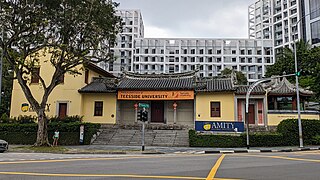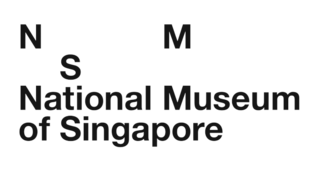

The Gemmill Fountain was the first public drinking fountain in Raffles Place, Singapore. It was eventually relocated to the National Museum of Singapore, where it currently stands.


The Gemmill Fountain was the first public drinking fountain in Raffles Place, Singapore. It was eventually relocated to the National Museum of Singapore, where it currently stands.
The marble fountain was donated by businessman John Gemmill, the first auctioneer in Singapore, in 1864, after Gemmill had already retired to London. The fountain featured a carved lion head, through which water ran. However, by 1939, water no longer ran through the fountain. The words "FOR THE USE OF ALL NATIONS AT SINGAPORE. THIS DRINKING FOUNTAIN IS THE GIFT OF JOHN GEMMILL, FORMERLY OF THIS ISLAND AND NOW OF LONDON" are inscribed on the front of the fountain. It was placed at Raffles Place, where it remained as late as 1919 before being moved elsewhere. [1] [2] The fountain was largely forgotten until it was found in a Municipal store in 1923, after which it was returned to the centre of Raffles Place. [1] By 1950, the fountain had been relocated in front of the Victoria Memorial Hall. [3] [4] It stood to the left of the Statue of Sir Stamford Raffles. [5]
During World War II, the fountain's water spout was damaged. The fountain was then brought to the National Museum of Singapore for safekeeping in 1967. Sand was placed in the fountain's basin to prevent the breeding of mosquitos. By 1970s, plans were being made to restore and potentially relocate the fountain. [6] The fountain was situated in front of the museum's Young People Gallery. It was repaired at a cost of $2,100 in 1974. [7] [8] By 1995, although the fountain was still operational, green algae had grown at its basin. [9] When the museum underwent renovations in 2002, the fountain was placed in the Heritage Conservation Centre. [10] [11] It was restored from September to December 2009 and placed at the outdoor terrace of the National Museum of Singapore. [12]

Cyril Northcote Parkinson was a British naval historian and author of some 60 books, the most famous of which was his best-seller Parkinson's Law (1957), in which Parkinson advanced the eponymous law stating that "work expands so as to fill the time available for its completion", an insight which led him to be regarded as an important scholar in public administration and management.

The Singapore sling is a gin-based sling cocktail from Singapore. This long drink was developed in 1915 by Ngiam Tong Boon, a bartender at the Long Bar in Raffles Hotel, Singapore. It was initially called the gin sling.

Raffles Place MRT station is an underground Mass Rapid Transit (MRT) interchange station on the North–South Line (NSL) and East–West Line (EWL) in Singapore. Located in the Downtown Core, the station is underneath Raffles Place south of the Singapore River. The station serves various landmarks including The Fullerton Hotel, Merlion Park and the Asian Civilisations Museum and various commercial buildings such as One Raffles Place and OCBC Centre.

The Singapore River is a river that flows parallel to Alexandra Road and feeds into the Marina Reservoir in the southern part of Singapore. The immediate upper watershed of the Singapore River is known as the Singapore River Planning Area, although the western part of the watershed is classified under the River Valley planning area.

Marina Bay is a bay located in the Central Area of Singapore, surrounded by the perimeter of four other planning areas, the Downtown Core, Marina East, Marina South and Straits View. The area surrounding the bay itself, also called Marina Bay, is a 360 hectare extension to the adjacent Central Business District. It is also the new downtown of Singapore, built on Singapore's reclaimed land.

Kwa Geok Choo was a Singaporean lawyer. She was the wife of Lee Kuan Yew, the founding Prime Minister of Singapore and the mother of Lee Hsien Loong, Lee Hsien Yang, and Lee Wei Ling.

The Temperance Fountain is a fountain and statue located in Washington, D.C., donated to the city in 1882 by Henry D. Cogswell, a dentist from San Francisco, California, who was a crusader in the temperance movement. This fountain was one of a series of temperance fountains he designed and commissioned in a belief that easy access to cool drinking water would keep people from consuming alcoholic beverages.

Elgin Bridge is a vehicular box girder bridge across the Singapore River, linking the Downtown Core to the Singapore River Planning Area located within Singapore's Central Area. It was built between 1925 and 1929.

The House of Tan Yeok Nee is a mansion building located at the junction of Penang Road and Clemenceau Avenue in the Museum Planning Area in Singapore. After an extensive restoration completed in 2000, it was held by the University of Chicago Booth School of Business. As of 2019, the building serves as the Singapore campus for Amity Global Institute.

Lau Pa Sat, also known as Telok Ayer Market, is a historic building located within the Downtown Core in the Central Area of Singapore. It was first built in 1824 as a fish market on the waterfront serving the people of early colonial Singapore and rebuilt in 1838. It was then relocated and rebuilt at the present location in 1894. It is currently a food court with stalls selling a variety of local cuisine.

The National Museum of Singapore is a public museum dedicated to Singaporean art, culture and history. Located within the country's Civic District at the Downtown Core area, it is the oldest museum in the country, with its history dating back to when it was first established in 1849, starting out as a section of a library at the Singapore Institution as the Raffles Library and Museum.

The Old National Library Building was a historical library building at Stamford Road in the Museum Planning Area of Singapore. Originally completed in 1960, the library building was a national icon for many Singaporeans. Despite a huge groundswell of public dissent, the library was closed on 31 March 2004, and was demolished in July that year to make way for the construction of the Fort Canning Tunnel to ease road traffic to the city. The controversy surrounding the building's demise has been credited for sparking greater awareness of local cultural roots and an unprecedented wave in favour of heritage conservation among Singaporeans.

The Revere Bell was a gift to Singapore by Mrs. Maria Revere Balestier, the daughter of Paul Revere and wife of the first American Consul to Singapore, Joseph Balestier. Cast by the Revere Copper Company in Boston, Massachusetts, it is the only Revere bell outside the United States. The bell is 81 centimetres (32 in) in height and 89 centimetres (35 in) in diameter with a clapper underneath. Maria Revere presented the bell to the first Church of St. Andrew in 1843 on condition that it be used to sound a curfew for five minutes at 8:00 pm every night. The curfew bell rang until 1855 when the church was demolished, and was resumed when the second church was constructed in its place in 1861 until it was permanently discontinued in 1874.

The Burnside Fountain is a non-functioning drinking fountain at the southeast corner of Worcester Common in Worcester, Massachusetts. It consists of two parts, a pink granite basin, and a bronze statue of a young boy riding a sea turtle.

The Fountains in Moscow once provided drinking water to Muscovites, and now decorate many of the city's squares and parks. Only one fountain built before the 1917 Revolution, the Petrovskiy Fountain in front of the Bolshoi Theater, still remains on its original site. Few fountains were built in Soviet times, but many new fountains were built in the 1990s and first decade of the 21st century during the city's post-Soviet economic boom. Because of the cold climate, the fountains only operate in the warm season, usually from May 1 until October 1.

Grand Army Plaza is a public square at the southeast corner of Central Park in Manhattan, New York City, near the intersection of Fifth Avenue and Central Park South. It consists of two rectangular plots on the west side of Fifth Avenue between 58th and 60th streets. The current design of Grand Army Plaza dates to a 1916 reconstruction by the architectural firm of Carrère and Hastings. The plaza is designated as a New York City scenic landmark.

Kenneth Michael Byrne was a Singaporean politician, diplomat and lawyer who served as Minister for Health between 1961 and 1963, Minister for Labour between 1959 and 1961 and Minister for Law between 1959 and 1963.

Public drinking fountains in Philadelphia, Pennsylvania, United States, have been built and used since the 19th century. Various reform-minded organizations in the city supported public drinking fountains as street furniture for different but overlapping reasons. One was the general promotion of public health, in an era of poor water and typhoid fever. Leaders of the temperance movement such as the Woman's Christian Temperance Union saw free, clean water as a crucial alternative to beer. Emerging animal welfare organizations, notably the Society for the Prevention of Cruelty to Animals, wanted to provide water to the dogs and working horses of the city on humanitarian grounds, which is why Philadelphia's drinking fountains of the era often include curb-level troughs that animals could reach.
John Gemmill was a British businessman, private banker, storekeeper, and the first auctioneer of Singapore. He donated the Gemmill Fountain to the public in 1864.

The Bust of a Chinese Gentleman is a bust of a Chinese man donated to the National Museum of Singapore by William George Stirling in 1939.